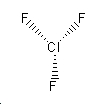It07:Chlorine Trifluoride
Chlorine Trifluoride
Introduction
Chlorine Trifluoride is a nearly colorless and corrosive gas at standard Temperature and Pressure. Due to it's corrosive nature, it can cause burns and serious damage to sensitive areas (such as eyes) if mishandled. Although it is a nearly colorless gas (a very pale yellow) it can be detected by it's peculiar “sweet” smell.
Preparation
ClF3 can be prepared via the fluoronation of ClF with F2 at 250 C;
| It07:Chlorine Trifluoride | |
|---|---|

| |
| General | |
| Systematic name | Chlorine Trifluoride |
| Other names | Chlorotrifluoride, Chlorine Fluoride |
| Molecular formula | ClF3 |
| Molar mass | 92.5 g/mol |
| Appearance | Yellow Gas/Liquid |
| CAS number | 7790-91-2 |
| Chemfinder ACX number | X1002864-3 |
| Properties | |
| Solubility in water | decomposes in |
| Vapour Pressure | > 101.3 kPa (@ 20 C) |
| Melting point | -76.3 C/196.7 K |
| Boiling point | 11.8 C/284.8 K |
| Structure | |
| Molecular shape | Trigonal bipyramidal |
| Coordination geometry |
sp3d |
| Dipole moment | 0.600 D |
| Hazards | |
| MSDS | Chlorine Trifluoride |
| Main Hazards | Corrosive, Toxic |
| NFPA 704 | 
|
| Flash point | N/A |
| RTECS number | FO2800000 |
| Supplementary data page | |
| Spectral data | UV/VIS, NMR |
| Related compounds | |
| Related compounds | ClF, BrF3, ClF5 |
| Except where noted otherwise, data are given for materials in their standard state (at 25 °C, 100 kPa) Infobox disclaimer and references | |
Hazards
Chlorine Trifluoride is a colorless, sweet smelling gas that is both toxic and corrosive. In low concentrations, it has neither noticeable effect on humans for either acute or chronic exposure. At high concentrations, however, the sweet smell becomes overpowering, causing breathing difficulties (coughing, spluttering, gasping) caused by irritation and damage to the lining of the lungs (corrosion to the alveoli). In addition to this, chemical pneumonitis and pulmonary edema (a filling up of the lungs with fluid) are also associated problems.
Contact with the eyes can also cause significant problems; irritation and tearing of the cornea, as well as corneal ulcerations can occur.
In liquid form, Chlorine Trifluoride is severely corrosive to both the skin and eyes. In concentrations of more than;
- >50% :causes immediate burning, erythema and tissue damage.
- 20%-50%:causes both pain and erythema, but the effects may be delayed up to 1-8 hours (depending on concentration)
- <20% :again, causes both pain and erythema, however the effects may be delayed up to 24 hours at such a low concentration.
"The fluoride ion acts as a direct cellular poison by interfering with calcium metabolism and enzyme mechanisms. Chronic exposure to low concentrations of chlorine trifluoride may cause fluorosis, and hypocalcaemia may occur following oral or extensive dermal exposure (NLM 1995)." {7}.
Applications
Aside from it's use in synthetic chemistry, Chlorine Trifluoride is used primarily in the cleaning of chemical chambers. It is used as an "in-situ plasma-less chamber cleaning agent", meaning that it has a wide sphere of uses and is sued in the cleaning of CVD (Chemical Vapour Deposition) and LPCVD (Low Pressure Chemical Vapour Deposition). It is also used to remove particle residue from a substrate processing operation, whilst it continues, without overetching the system components. This means that the system can be continually cleaned without stopping the process, minimising costs and optimising profits. If one area of the system accumulates residue faster than others (almost always the case), then you can preferentially heat that area to simply increase the rate of residue removal.
Reference
- Bonding and Hybridization
- R. D. Nelson Jr., D. R. Lide, A. A. Maryott "Selected Values of electric dipole moments for molecules in the gas phase" NSRDS-NBS10, 1967
- U.S. Department of Labour
- Über ein neues Chlorfluorid-CIF3 DOI:10.1002/zaac.19301900127
- Center for Disease Control
- Max-Planck-Gesellschaft (UV/VIS Spectrum)
- Dangers of Chlorine Trifluoride
- Process for chlorine trifluoride chamber cleaning
- Chlorine Trifluoride-CVD LPCVD Applications
- Process for chlorine trifluoride chamber cleaning
